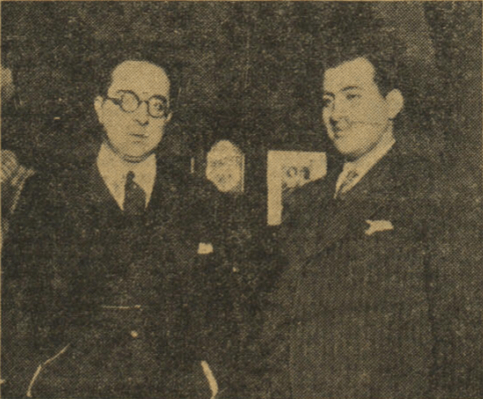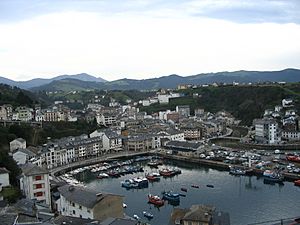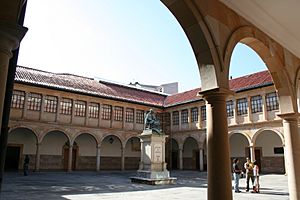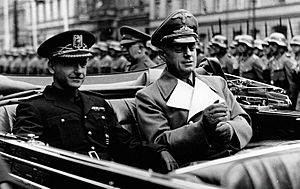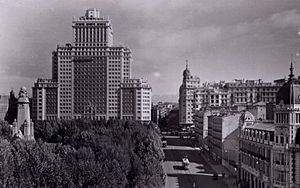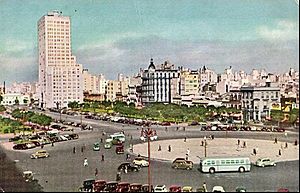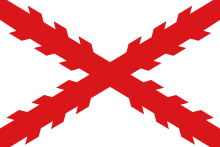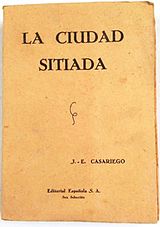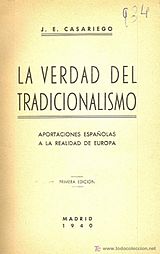Jesús Evaristo Casariego Fernández-Noriega facts for kids
Quick facts for kids
Jesús Evaristo Casariego Fernández-Noriega
|
|
|---|---|
|
|
|
| Born |
Jesús Evaristo Casariego Fernández-Noriega
1912 Tineo, Spain
|
| Died | 1990 Luarca, Spain
|
| Nationality | Spanish |
| Known for | writer |
| Political party | Carlism |
Jesús Evaristo Díaz-Casariego y Fernández-Noriega (born November 7, 1913 – died September 16, 1990) was a Spanish writer and publisher. He was very popular during the early and middle years of Francoist Spain, a period when General Francisco Franco ruled Spain.
Casariego wrote about 60 books and booklets. Most of these were popular history books. However, he was best known as a novelist, especially for his book Con la vida hicieron fuego (1953). In the early 1940s, he managed a newspaper called El Alcazár. He was also active in a political movement called Carlism when he was young and when he was older. Today, his novels are not considered top-tier literature. But he is still recognized as an expert on the culture and history of Asturias, a region in Spain.
Contents
Early Life and Education
Jesús Evaristo Casariego's family had a long history in Western Asturias. One of his famous ancestors was an admiral who governed Spanish Florida in the late 1500s.
His grandfather, Evaristo Díaz-Casariego y López-Acevedo (1849-1930), served in the navy. He fought in the Spanish–American War. He also wrote some manuals about the navy. Jesús Evaristo's father, Jesús Díaz-Casariego Pazos, became a dentist. He worked in Luarca and Gijón.
In 1913, his father married Ramona Fernandez Noriega from Tineo. They settled in Luarca and had six children. Jesús Evaristo was the oldest.
As a child, Jesús Evaristo was mainly raised by his grandparents. They taught him in a very traditional way. He spent his early years in Luarca and Tineo. He later studied law at the University of Oviedo and graduated in Madrid in the early 1930s.
Even though he trained as a lawyer, Casariego was interested in writing. Many of his relatives also enjoyed literature. In the mid-1930s, he studied history in Germany. By 1929, he was already writing for the local Asturian newspaper Región. In the early 1930s, he wrote for Madrid newspapers like La Nación and El Siglo Futuro.
In 1935, Casariego married María Paz Aguillaume Cadavieco. Her grandfather was French and helped build railways in Asturias. Jesús Evaristo and María Paz lived in Madrid and had four daughters: Carmen, María Paz, Margarita, and Julia. Three of them later worked in culture, including writing, film, and history.
Involvement in Carlism
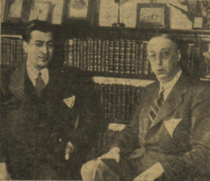
Casariego grew up in a family with ties to Carlism. This was a political movement that supported a different royal family for the Spanish throne. Some of his distant relatives had fought in the Carlist Wars.
In the early 1930s, while at university, he openly supported the Carlist leader Don Jaime. He joined the Carlist youth groups in Oviedo and Madrid. In 1933, he wrote a short book about the Carlist ideas. The Carlist political leader, conde de Rodezno, wrote the introduction.
From 1932, Casariego worked for the newspaper La Nación. He also wrote for the main Carlist newspaper El Siglo Futuro. He reported on the Asturian Revolution in 1934. He was known as a traditional journalist and faced some danger in Madrid. He also helped organize events to honor the Carlist soldiers, called requetés, who fought in Asturias.
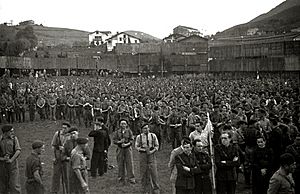
When the Spanish Civil War began in July 1936, Casariego was in Asturias. He joined the Carlist requeté soldiers who defended Oviedo. Oviedo was held by the Nationalists but surrounded by the Republicans. He fought until at least early 1937. He was an officer, possibly a lieutenant or captain. He later said he was wounded while fighting. He also entered Barcelona with the winning Nationalist troops in early 1939. People recognized his bravery during the war.
Leading El Alcazár Newspaper
After the Nationalists won the Civil War, Casariego returned to Madrid. He became close to important people in Francoist Spain, like Ramón Serrano Suñer. Casariego wanted to restart some newspapers. In October 1939, he became the director of El Alcázar, a newspaper that moved from Toledo to Madrid.
His time at El Alcazár had some disagreements with the owners, led by General Moscardo. These were more about how to manage the newspaper than about politics. Both sides blamed each other for low sales. In 1942, an official investigation helped Casariego's position.
As a newspaper envoy, he traveled through Europe during the war. He interviewed leaders like Hitler, Mussolini, and Churchill.
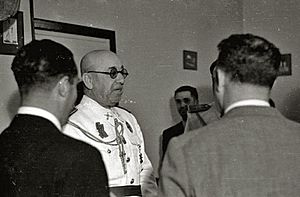
El Alcazár strongly supported the new Spain under Franco. It praised Franco and the Falange. Casariego also kept his Carlist ideas in the newspaper. He made sure that former staff from El Siglo Futuro found jobs at El Alcazár.
The newspaper also showed strong support for Germany. Casariego even wrote a poem praising Hitler as a leader against communism. However, when Spain's foreign policy changed, the government wanted less pro-German content. The newspaper's board used this chance to remove Casariego. He left El Alcazár in June 1944.
Later Career: Scholar and Correspondent
Even after leaving El Alcazár, Casariego was still respected in some government circles. He met with Franco in 1946 and 1948.
In the early 1940s, he started an academic career. In 1941, he earned a PhD for his work on Spanish law in America. This allowed him to teach at the University of Madrid. He taught a course on the history of Spanish institutions in America until at least 1949. In Madrid, he also organized literary gatherings and gave lectures at various cultural centers. He sometimes wrote for other Madrid newspapers.
Casariego stepped back from active Carlist politics during this time. He didn't join political groups or write for Carlist newspapers. Some Carlists felt he had betrayed their cause because of his strong support for Franco.
In the mid-1950s, Casariego returned to journalism. He worked as a special reporter for the newspaper ABC. He spent time in Latin America, including Argentina and Cuba, in the late 1950s and early 1960s. He wrote a lot for ABC's weekly magazine, Blanco y Negro.
When he returned to Spain in the mid-1960s, he settled in his hometown of Luarca. He focused on culture and history, collecting old manuscripts and documents. He also resumed teaching at the University of Oviedo. By 1966, he was a "professor of history" and directed the Seminar on Contemporary History of Asturias until the early 1970s. He became a leading expert on Asturian history and culture, working with the Oviedo-based Instituto de Estudios Asturianos.
Return to Politics and Asturian Studies
In 1969, Casariego wrote a legal document supporting the citizenship rights of the Borbón-Parma family, who were connected to the Carlist cause. In 1970, he sent a public letter to the Carlist leadership. In it, he criticized the party's left-leaning direction and emphasized traditional Carlist ideas. He suggested a big Carlist meeting outside Spain to decide the party's future.
In the early 1970s, Casariego joined efforts to strengthen traditional Carlist views. He published a booklet and wrote for the newspaper El Pensamiento Navarro. He also signed open letters and planned to start a traditional newspaper.
When Franco died, Casariego was among the traditional Carlists who felt left out by the more left-wing Partido Carlista. In the mid-1970s, he helped found Comunión Tradicionalista, a group that tried to bring back traditional Carlism. He ran for Senate in the 1977 elections but did not win. He also ran in 1978 and lost again.
Despite these losses, he sometimes took on a high-profile role in right-wing groups. In November 1978, he was a main speaker at a large rally in Madrid against a new constitution. This event was the peak of his political career. After 1979, he mostly withdrew from politics.
For ten years, Casariego was involved with the Institute of Asturian Studies. In 1978, he was elected its first director and held the position for 12 years. His public work in the 1980s was almost entirely about Asturian topics. He also wrote for the Institute's bulletin. He was very interested in the Asturian language, called bable. He promoted it and helped start a group called Amigos de los Bables. He also gave lectures at local events. Despite his public recognition, he faced financial difficulties later in life.
His Writings
Many people knew Casariego best as a novelist. His novels Flor de hidalgos (1938), La ciudad sitiada (1939), and his most famous, Con la vida hicieron fuego (1953), are all set during the Civil War. The first two tell stories of Carlist soldiers fighting Republicans. Con la vida hicieron fuego is similar but has a more thoughtful tone. El mayorazgo navegante (1944) was an adventure story set in the past.
Casariego also wrote poetry, though it was less popular. Some of his poetry collections include Romances modernos de toros, guerra y caza (1945) and Mares y veleros de España (1953).
Most of Casariego's books are about historiography, which is the study of history. He was very interested in the greatness of Hispanidad, which refers to the shared culture of Spanish-speaking countries. Important works in this area include Grandeza y proyección del mundo hispánico (1941) and Exaltación y estirpe de las cosas de España (1944). He also wrote more detailed studies like Historia del derecho y de las instituciones marítimas del mundo hispánico (1947).
In the last 30 years of his life, Casariego focused on the history and culture of Asturias. He wrote about 15 books on this topic. A notable one is Historias asturianas de hace más de mil años (1983). Other works include Las Asturias guerrera (1976) and Oviedo en la historia y la literatura a través de 1200 años (1987).
He also explored specific subjects. His interest in maritime history is clear in Los orígenes del Derecho Marítimo (1947). He also wrote about the history of weapons and hunting in books like Tratado histórico de las armas (1962) and Armas de España (1984).
His least known works are about politics. Some were general pamphlets supporting his views, such as España ante la guerra del mundo (1940). Others were about the history and ideas of Carlism, like El Tradicionalismo como doctrina del derecho político (1933) and La verdad del Tradicionalismo (1940).
See also
 In Spanish: Jesús Evaristo Casariego para niños
In Spanish: Jesús Evaristo Casariego para niños
- El Alcázar
- Traditionalism (Spain)
- Carlism
- Carlo-francoism
- Carlism in literature


